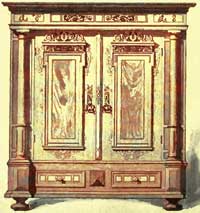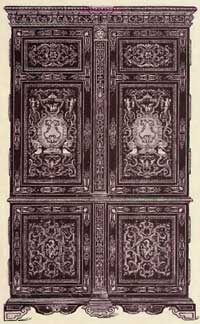French Armoire
Gothic period armoire
Until the end of the 13th century, the French armoire was decorated mainly with paintings executed on the doors’ panels, and elaborated ornamental hinges. Starting with the 14th century, the wood was sculpted, and then painted, or gilded, and the French armoire began to display a more architectural character.
A masterpiece of the French Gothic furniture, one of the most wonderful Gothic armoires is the one kept in the treasury of Noyon Cathedral, dating from the 13th century.
The Renaissance armoire
The Renaissance French armoires, as it happened with all the furniture of the period, were influenced by the Italian Renaissance furniture. However, the French craftsmen did not simply copy the Italian models, but modified them according to their own taste.

French Armoire - Louis XIII Style
The French armoires of this period were enriched with carving representing goddesses, flowers, eagles or sirens, according to the classical influence. Other newly introduced ornamentations were capitals with floral motifs, carved figures, dolphins, and flat mouldings.
Generally, the French armoire had four folding doors, two above and two below. They were separated by pilasters displaying carved figures. Sometimes, the armoire had niches displaying statuettes, stressing even more the architectural character of the piece. All the armoires were covered with paintings and gildings.
A cabinet resembled an ordinary chest placed upon a stand, opening, not at the top, but with one or more folding-doors on one side, with drawers inside. When keeping valuables, the armoire was a “de luxe” one, as the makers were decorating it as lavishly as possible.
The Italian artists chiefly excelled in the construction, and still more in the decoration of cabinets. As a result, from the end of the 16th century, the demand for pieces exported from the Italian Peninsula increased considerably. Italian manufacturers used exotic woods, inlaid with coloured marquetry, ivory, shells, mother-of-pearl, enriched with jewellery.
The use of bronze for the ornamentation of the French armoire was also of Italian influence, the cabinet makers of Italy extensively using combinations of gold and silver. The use of tortoise-shell plaques was suggested by the Florentine style mosaics worked into the little cabinets and the tops of the tables.
Ebony, originally used only in marquetry, was employed for the construction of the entire cabinet at the beginning of the 17th century. In the same period, the German cabinets were much in favour, especially due to their detailed fine carving. During the reign of Louis XIII, the styles of ornament became more varied, with much scroll and shell carving. Influenced by the Italians, the French used gilded bronze, and inlaying of gold and silver in iron, known as damascening.
Louis XIV Armoire
Under Louis XIV, the French armoire is defined by the grandeur of style, to which contributed, among others, Andre Charles Boulle. He used ormolu and introduced the elaborated marquetry of tortoise-shell and brass which came to be known as Boulle work.

French Armoire - Boulle Work
A common form of cabinet had a serpentine front and carved feet and panels, decorated with Boulle ornaments.
The main woods were oak, walnut, chestnut, and ebony, with ornaments done in rosewood, sandal-wood, or tulip-wood. There was much gilding, marquetry and carving, with mounts and inlay of onyx, porphyry, lapis-lazuli, ormolu, brass, and colored woods. The French armoire became sumptuous, decorated with bronze figures of deities, or medallions representing allegorical religious scenes.
Louis XV Armoire
The French armoire of the Louis XV style was made of mahogany, as well as cherry and cheaper woods painted and gilded. Marquetry was not employed extensively, though sometimes the larger pieces used an inlay of tulip, rosewood, maple, and amaranth. The doors and panels of cabinets were often veneered, with the grain of the wood running diagonally. During the period, the Martins invented a lacquer finish, made in red, brown, gold, speckled bronze, and even black, which was used on cabinets.
Louis XVI Armoire
The fluted column in the form of a pilaster became an important ornament of the French armoire. In place of arms, armor, weapons, and the victor's palm of Louis XIV, or the Watteau and Boucher pastorals of the Louis XV style, these medallions were classic in subject, representing musical instruments, Cupid's quiver, baskets and garlands of flowers, wreaths and bay-leaves.
Probably the greatest cabinet-maker of the period was Riesener, who had gained fame and experience during the previous reign. He was a master of marquetry, using woods like pigments.
The woods were oak, walnut, and mahogany, mahogany being more popular than walnut. Ormolu mounts continued in use on the larger furniture, and also inlay of tulip, rose, pear, holly, mahogany, and ebony.
The style of this period was showing more of the wood than the Louis XV furniture. Bronze mounts were still used, particularly on the dark wood pieces, but Boulle's inlay of tortoise-shell had gone out of fashion. Large pieces, such as vitrines, cabinets, commodes, desks, were commonly made of dark, polished wood, with metal mounts and occasionally inlay. Sometimes they were furnished with marble tops.
The French Armoire during the Empire
Mahogany was the wood most used by the cabinet-makers of the Empire period, both solid and veneered, enriched with applique. Marquetry was discarded and there was only a moderate amount of carved wood, but much plain surface embellished with finely modeled brass, bronze, gilt, and ormolu mounts.
The supports of consoles, cabinets, bookcases, showed little style in the rear, being sometimes merely flat boards, but the front legs were usually more elegant, often tapering, crowned with the female bust, and with feet of ormolu.
The decorative details of the French armoire during the Empire were significant and symbolic, reflecting the glory of the Emperor.
